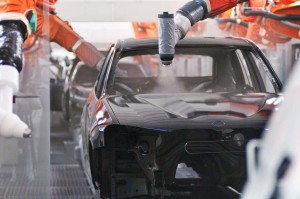It may be a “German” automaker, but BMW is counting on its assembly plant in Spartanburg, South Carolina, to help drive its goal of increasing sales by 55% before the end of the coming decade.
And to get there, the maker is pumping an extra $750 million to expand the factory, known internally as plant 10, which has become its critical source for multipurpose vehicles like the X5 and the newly-updated X3.
“We will continue to invest” in Spartanburg, proclaimed BMW’s chief Nortbert Reithofer, who was present at a ceremony to celebrate the completion of the newly-expanded factory.
Though “plant 10” has produced a wide range of products since it first opened, nearly two decades ago, it today focuses on BMW’s so-called “sport-activity vehicles.” And for good reason, considering the huge demand for such products in the States. But sales are growing worldwide, making the Spartanburg plant today one of the biggest exporters – on a dollar basis – of any factory in the U.S.
A full 70% of the vehicles produced in the South Carolina facility are exported.
Building demand with new models, such as the revised 2011 X3 is critical if BMW is to achieve the projects sales growth of 55% — to a total of 2 million vehicles per year — by 2020.
But Spartanburg alone won’t be able to handle that hefty increase, and Reithofer said that BMW needs to build an all-new plant, though he declined to name a location. Last April, on the eve of the Beijing Motor Show, he said that the X1 could be one of the models to be produced at the company’snew Chinese plant in Tiexi, in Shenyang province.
“Together with the Chinese authorities we are investigating the possibilities,” said Reithofer, adding that, the investment will be 560 million euro, half on the account of BMW and the other half on the account of its Chinese partner, Brilliance. The yearly capacity of the Tiexi plant is planned to be around 100,000 units in 2012.
The company started production in Spartanburg in 1994 with the 3-Series, followed by the Z3 and Z4. Since 1999 BMW has been using the factory to assemble the X5, and since 2008 the X6.
In the past sixteen years the plant produced more than 1.6 million vehicles overall. With the new extension the yearly capacity can be cranked up from 160,000 to 240,000 units.
The 1.2 million square-foot expansion includes a body shop, assembly hall and paint shop.
BMW started production of the second generation of the 2011 X3 in September. Approximately 1,600 extra jobs were opened up, in addition to the existing 6,000 employees. An external report states that directly and indirectly BMW generates 23,000 jobs in South Carolina.
BMW has been emphasizing the environmental friendliness of its American plant. In Spartanburg the new paint shop uses the so-called IPP, or Integrated Paint Process, an electronically-managed system that eliminates several traditional steps, leading to a 30% decrease of energy usage and, consequently, to a 45% reduction in CO2-emissions. That, the maker claims, is a savings of 92,000 tons per year.
Methane gas from a nearby landfill powers around half of the energy needs of the plant. Total savings amount to around $5 million per year.
The extension should allow BMW to remain the number one European premium brand on the U.S. market, it contends. But its German competitors, especially Mercedes-Benz, are closing the gap.
The second generation of the X3 will probably be joined by yet another model line. During the celebration in Spartanburg, Jim O’Donnell, president of BMW North America, said that BMW will introduce its small X1 model in this market in the first half of 2011.
Frank-Peter Arndt, BMW Group board member, denied later that evening, the existence of such plans.
BMW’s philosophy is to build a model line in the country where it is best sold. With respect to the X3 the US market is good for 50% of worldwide sales.
The German newspaper Handelsblatt reported a day after the ceremony that BMW is considering building the 3-Series passenger car model in the US. It will be financially easier to compete with the C-Class that is produced in the Mercedes plant in Tuscaloosa, Alabama.

